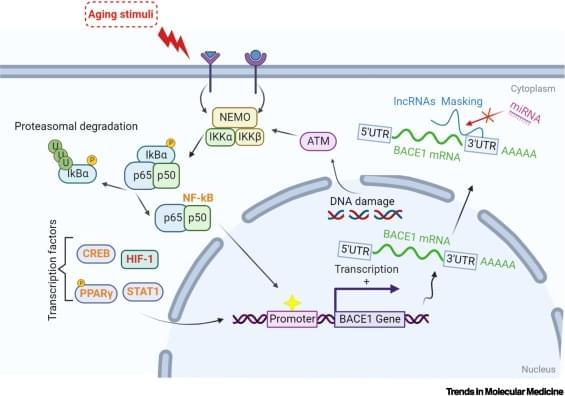The two American allies are signing on to the U.S. offensive against China’s flagging chip industry.



The BACE1 enzyme has a rate-limiting role in the amyloidogenic pathway (see Glossary) and has been extensively studied for its neuronal functions[1]. Since 2000, intensive efforts have focused on developing small-molecule BACE1 inhibitors to reduce amyloid β (Aβ) production in Alzheimer’s disease (AD) brains. However, human clinical trials involving most BACE1 inhibitors were stopped at Phase 2/3 due to limited therapeutic benefits[2]. BACE1 inhibitors act by reducing Aβ-related pathologies in AD brains, that is, they are used to treat the symptoms rather than the underlying disease.

While grand spaceflight plans of some nations have ended up many years behind schedule, China completed the assembly in orbit of its Tiangong space station in late October, only 22 months later than planned. And on Nov. 29, the Shenzhou 15 mission blasted off from China’s Jiuquan Satellite Launch Center deep in the Gobi Desert and took three astronauts to the space station to begin permanent occupancy of the outpost.
These human spaceflight achievements, combined with recent space probes to the moon and Mars, add to the evidence that China is running a steady space marathon rather than competing in a head-to-head space race with the United States. That China’s space program is making good time toward its long-term goals was reinforced during a rare visit for foreign media to the country’s heavily guarded desert rocket base for the Nov. 29 launch — including lengthy interviews with senior Chinese space officials by in for The New York Times.
It was supposed to be just another spacewalk, a simple routine inspection.
SEO keywords: science fiction space sci-fi spacex nasa astronaut elon musk mr. beast pewdiepie please don’t judge me for this I am a slave to the digital god.
Let’s talk about AI Art, Lensa, ChatGPT, and why it’s all deeper than you think.
Save money with Karma at https://shop.karmanow.com/marques_dec22 and get double the Karma cash for a limited time!
The sweater: http://shop.MKBHD.com.
Search LAION-5B: https://haveibeentrained.com.
Tech I’m using right now: https://www.amazon.com/shop/MKBHD?tag=lifeboatfound-20
Intro Track: http://youtube.com/20syl.



Clean energy will reduce dependency on Russia and Arab countries for oil and gas.
What if the weight could instead be distributed between multiple support poles? That’s the design Eolink has in mind; its floating turbine swaps out the single large pole for four thinner ones angled towards each other in a pyramid shape. This not only distributes the weight of the turbine’s pieces, it allows the whole structure to be lighter.
The turbine Eolink plans to build as a proof of concept will have a generating capacity of five megawatts and weigh 1,100 tons. Its base will be a square with each side 171 feet (52 meters) long, and its rotor’s diameter will be 469 feet (143 meters). For reference, that’s about one and a half Big Bens, or four-fifths of the Washington Monument.
You wouldn’t think that such a huge piece of machinery would be simple to build and transport. But compared to conventional offshore turbines, Eolink’s design does carry a myriad of advantages in terms of both cost and ease.
FTX founder Sam Bankman-Fried was arrested in the Bahamas at the behest of US prosecutors on Monday, the day before he was due to testify before Congress about the abrupt failure last month of one of the world’s largest cryptocurrency exchanges.
#FTX #SamBankmanFried #Bahamas.
About Channel:
WION The World is One News, examines global issues with in-depth analysis. We provide much more than the news of the day. Our aim to empower people to explore their world. With our Global headquarters in New Delhi, we bring you news on the hour, by the hour. We deliver information that is not biased. We are journalists who are neutral to the core and non-partisan when it comes to the politics of the world. People are tired of biased reportage and we stand for a globalised united world. So for us the World is truly One.
Please keep discussions on this channel clean and respectful and refrain from using racist or sexist slurs as well as personal insults.
Check out our website: http://www.wionews.com.

Solar cell technology is a seen as a key pillar in our transition to cleaner forms of energy, but within this field there is all kinds of room for experimentation. Solar cells that are thin and flexible hold unique promise in the area, as they could be applied to all kinds of irregular, curvy or otherwise unsuitable surfaces. Thinner than a human hair, a new lightweight solar cell from MIT scientists continues to push the envelope in this space.
The MIT team behind the technology sought to build on its previous advances in material science, which in 2016 culminated in ultra-thin solar cells light enough to sit atop a soap bubble without breaking it. As is the case with other thin, light and flexible solar cells we’ve looked at over the years, this pointed to all kinds of possibilities, from paper-based electronics to lightweight wearables that harvest energy throughout your day.
Despite the potential, the team still had some problems to solve, with the fabrication technique for the solar cells requiring vacuum chambers and expensive vapor deposition methods. In order to scale the technology up, the scientists have now turned to ink-based printable materials to streamline the process.